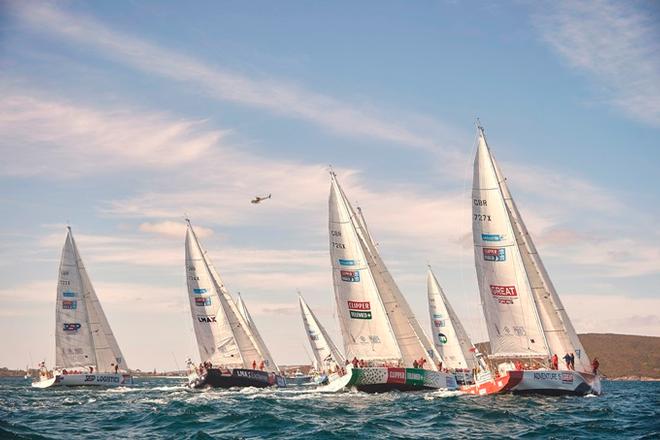Clipper Race- Da Nang to Qingdao—Sailing news from the U.S. and beyond
by David Schmidt, Sail-World USA Editor on 26 Feb 2016

The start of Race Four of the 2015/2016 Clipper Round the World Race Clipper Ventures
When the topic of distance racing arises, I usually find myself remembering perfect starlit nights, or flying kites by moonlight. Of course the temperatures are warm enough to allow the on-watch crew to wear t-shirts and sneakers on deck, of course the wind is from our stern quarter, and of course there’s hot coffee belowdecks for the asking. The boat’s motion is comfortable, of course, there are no wind holes on the racecourse, and the following seas only increase VMG when the puffs hit at the right time. In a word, magic.
The hard-boiled reality, of course, is often far from this utopian vision of offshore living, as the crews of the Clipper Round the World Race are likely to discover first hand this Saturday (February 27), when the fleet aims their bows from Da Nang, Vietnam to Qingdao, China, home of the sailing portion of the 2008 Beijing Olympics.
For anyone just tuning in to our coverage of the Clipper race, this event places professional skippers aboard identical, 70-foot Tony Castro-designed monohulls that are crewed by amateur sailors who pay to take part in training courses, as well as the race. Since the Clipper is run as a series of stage races, sailors can choose to participate for one or more legs, or they can go big and lap the planet.
According to the Clipper Round the World Race’s founder, Sir Robin Knox-Johnston, the leg from Da Nang to Qingdao will likely test each team’s ability to stay focused amongst physical distractions such as bitter-cold temperatures and freezing rain and will offer plenty of opportunity to master the finer points of trimming a jib for close-winded uphill sailing.
“This leg is usually a beat, nearly all the way, and certainly from Taiwan onwards,” said Knox-Johnston in an exclusive Sail-World.com interview a few days prior to the leg’s start. “The current information is scant but generally goes with the monsoonal winds. Thus it can be expected to be adverse. Finding the weaker current could prove very advantageous.”
While Knox-Johnston was careful to explain that this leg will see smaller seas than the mountains of saline that the crews faced in the Southern Ocean, he was also careful to explain that square waves without backs have caused plenty of breakages in other round-the-world races that have visited these waters.
“It’s the cold that’s different [on this leg],” said Knox-Johnston. “The northerly winds are coming across eastern Asia from the Arctic, frequently bringing sleet and snow. It is a tough leg. Remember when the Volvo [Ocean Race] went there [in 2008/2009]? Seven [Volvo Open 70s] left Singapore, [and only] three arrived in Qingdao.”
As for the personal toll, Knox-Johnston expects that a certain baptism by suffering will take place. “Three Clipper Races ago, when I met the boats, I spoke to one weather-beaten crewmember as he stepped ashore in Qingdao and he said that leg was the toughest thing he had every experienced, but he felt he was a real sailor now,” said Knox-Johnston.
Others agree with Knox-Johnston’s assessment. “It’s going to be a big strong beat up windward, so [knowing] when to put the tacks in, which currents to find and which currents to get out of,” said Bob Beggs, skipper of Qingdao in a Sail-World.com interview. “So, lots of tactical decisions, with weather fronts coming through…and positioning yourself in the right place [relative to the fleet] to take advantage of the changing weather.”
“It’s going to be short and sharp,” said Peter Thornton, skipper of Great Britain and Northern Ireland. “This [leg], I think we’re going to be shocked by the short and sharpness of the seas because it’s relatively shallow and the seas can whip up. So, it’s going to be difficult to deal with the slamming and pounding of the boat, and trying to get that balance correct between sails and direction is going to be key.”
As for the challenge of leading people through a possible pounding, both Thornton and Beggs were confident that solid leadership and safe seamanship will keep the fleet clear of the bricks, metaphorical or otherwise.
“It’s about teamwork…and getting all the little things right,” said Beggs. “It’s the little things, the little mistakes that you make that let you down… It’s about minimizing the damage and minimizing the mistakes and just optimizing all the good stuff that you can do.”
Some of that good stuff, of course, involves looking after one’s vessel and crew. “Keeping that morale up,” said Thornton when asked about the biggest hurdles facing his team en route to Qingdao. “When it does get tough, it’s making sure that people are eating and drinking and keeping up their energy levels and hopefully still getting some sleep so that they can function when needed.”
Racing starts this Saturday, so stay tuned to Sail-World.com for the latest Clipper news, as it unfurls.
May the four winds blow you safely home,
If you want to link to this article then please use this URL: www.sail-world.com/142576